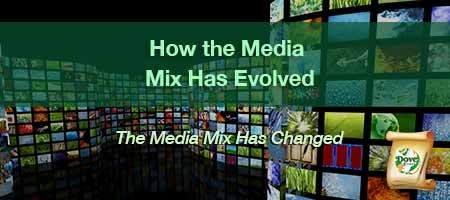How the Media Mix Has Evolved
Our Quote of the Day:
"Good marketing makes the company look smart. Great marketing makes the customer feel smart."
— Joe Chernov
Audience Ad Exposure Not Guaranteed
There is a perception among marketing professionals that brilliant creative is sure to attract audiences directly because of the creative itself. Although no longer the norm in the marketing world, some can argue that this creativity construct remains true due to the occasional breakthroughs. For example, country singer Walker Hayes's song, "Fancy Like," which highlights TikTok creative is catchy enough to break the mold and draw audiences in with dancing, sing-along, and ideally fancy-like dining at Applebee's. However, most marketers would agree that the creative in this example is the exception and not the rule for audience ad exposure.
Specific benchmarks help to illuminate why advertisements, in general, do not guarantee that audiences will see them. The main challenges relate to media bias, audience fragmentation, media compression, and non-performing creative.
Regardless of the channels marketing strategists choose to invest in, it will not make much difference if the advertisements lack creativity but have multiple channel placement in hopes that audiences will see them. The process of ad exposure must go deeper with a more nuanced, more deliberate focus given to ad creation and placement channels.
The Three Laws
To overcome the lack of audience exposure, Incite suggests that three laws should govern the creative pathway. Together, the following laws should help to address media channel challenges:
1. Participation - Interaction and Immersion
2. Coherence - Integration across time and space
3. Relevance - Message and media content
The three laws are all reasonably straightforward as stated; however, achieving success by using the laws as the primary driver behind ad development and content messaging requires a higher level of understanding and commitment. To help harness the laws of audience participation, coherence, and relevance, Incite suggests adhering to 10 principles to help marketers stay on a path to success.
The 10 Principles
Throughout every walk of life, some principles outline a path to achieve results. Whether rewarding or punishing, these results come about by adhering to the tenets or by ignoring them. So it is with media best practices that in turn become principles. In this case, Incite believes the following ten principles can significantly aid in developing the groundwork for achieving the three laws concept.
1. Set KPIs and Budgets according to advertising assignment and audience
2. The second and third exposures are not worth more than the first exposure
3. Achieving media scale is critical for effectiveness and penetration
4. Advertising that is effective in the long term will also work in the short term
5. Brand building improves activation and overall performance
6. Don't rely on a single channel, as integrated campaigns perform better
7. It's no longer about media fit because divergent media can achieve more than one thing
8. Improve integrated channel impact by engaging audiences where they are most receptive
9. Unconventional media can amplify audience interest in a message
10. Interest-based targeting can prime audiences and address the intent
Not all ten principles are novel; however, the principles should be part of the creative strategy toolbox. Marketing teams can help ensure that brands have a more robust roadmap to execute a plan to deliver more successful outcomes. Beyond the ten principles, there are a set of 10 questions that require answers beyond basic questions such as market conditions, the economy, and the state of a particular industry sector.
The 10 Questions
Among many questions that media and marketing teams banter about during strategy meetings, Incite suggests that the following questions can help provide a more refined assessment during the early stages of media planning.
1. How will media help reach and engage your target audience?
2. Are you integrating paid, owned, and earned channels?
3. Do you consider both time spent and channel influence?
4. What level of affinity does your target audience have for a medium?
5. How does your audience use/engage with the channel?
6. Can the channel reach enough of your audience in time?
7. How much will you need to spend to use a particular channel effectively?
8. Can you cut through the noise cost-effectively in a given channel?
9. Does the channel provide a quality environment that improves attention?
10. What roles will a channel play to deliver engagement that runs deep and lasts long?
Undoubtedly, brands and marketers will have other strategic questions to discuss; however, these questions help fine-tune the process of asking relevant marketing questions as a starting point.
Five Channels that Improve Performance
In this rapidly changing and evolving media environment, the task at hand is to commit to remaining diligent. Ebiquity suggests that brands need to commit to at least five channels to improve performance by 35% or more. Depending on the industry and target audience, brands will find that specific channels are more effective than others. There is a multitude of distribution channels, communication channels, and service channels. Ebiquity notes that channel integration improves overall performance.
In terms of media, the TV scale has the highest impact on long-term performance. Given that TV has a strong influence over the long term, this, in part, can explain why video is such a high-performance medium in 2021. Meanwhile, the online display produces the lowest incremental profit return because of online content and channels bombardment. Lastly, direct mail is one of the most underestimated channels, given its actual performance versus perceptions. Those who invest in direct mail see the results, which explains why the medium is experiencing a resurgence in light of surging digital ad buys. These numbers help explain how and why channel integration is critical for each marketing campaign. Further, a review of the data, a/b testing and other marketing tools can help improve channel performance. Guesswork or intuitive perspectives are not options.
The Net-Net
As the media mix evolves, brands must measure each channel's strengths and weaknesses against the budget and goals. While digital is surging, TV remains impactful. Moreover, although direct mail continues to be the most misunderstood medium, it is also the one medium that can make a notable difference and improve the overall marketing mix. The goal will always be to select media channels that deliver the best engagement while being cost-effective and appealing to the target audience. We hope you found value in this article, and thanks for reading "How the Media Mix Has Evolved!"
Let's talk about integrated business solutions and how they can move your messages forward, help grow your business, change behavior, and improve the customer experience. Let us show you how to improve your document processes to optimize your workflow, reduce costs, and maximize your organization's printing, letter shop, and mailing capabilities.
Dove Direct has an official USPS certified bureau located within our offices to save you time and money. We can also create a demo file for you. For more information, please call Carla Eubanks at 404-629-0122 or email Carla at This email address is being protected from spambots. You need JavaScript enabled to view it..
Dove Direct, your Atlanta vertical integrated print and mail solutions provider, offers organizations end-to-end data, printing, and mailing solutions:
- Data Management
- Variable Digital/Data Printing
- LetterShop and Fulfillment
- Digital Mail Scanning Services
- Fully Automated MLOCR Presort Bureau
- Marketing and Production Management Support
- Secure Data Life Cycle Management
If you don't want to wait, you can reach Dove Direct today by calling 404-629-0122 or completing the Contact Form.





